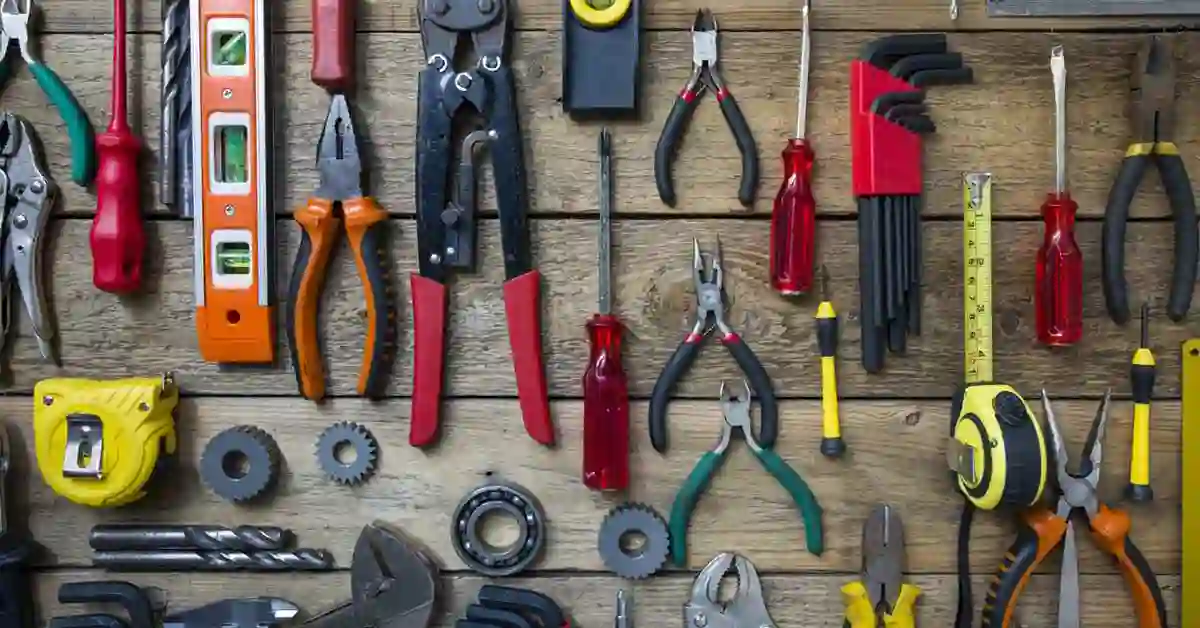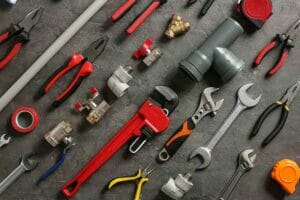
As a plumber, having the right tools for the job is essential to delivering quality service and building a successful business. There are various types of plumbing tools that you should have in your arsenal to ensure that you can handle any plumbing job that comes your way in addition to helping you grow your plumbing business. In this article, we will discuss 50 must-have plumber tools for a plumbing business.
Must-Have Plumber Tool List
1. Plunger
A plunger is one of the most important tools that a plumber can have. It is used to clear blockages in sinks, toilets, and drains.
2. Drain Snake
A drain snake is used to clear clogged drains that cannot be cleared with a plunger. It can reach deep into pipes to remove blockages.
3. Pipe Wrench
A pipe wrench is used to tighten and loosen pipe fittings. It is adjustable and can be used on different sizes of pipes.
4. Basin Wrench
A basin wrench is a specialized tool used to tighten and loosen nuts and bolts that are hard to reach, such as those found under sinks.
5. Adjustable Wrench
An adjustable wrench is a versatile tool that can be used on a variety of different-sized nuts and bolts.
6. Tongue-and-Groove Pliers
Tongue-and-groove pliers are used for gripping and turning pipes, fittings, and nuts.
7. Hacksaw
A hacksaw is used to cut through metal pipes and fittings. It has a replaceable blade for easy maintenance.
8. Pipe Cutter
A pipe cutter is used to cut pipes cleanly and evenly. It is a quick and efficient way to cut pipes.
9. Teflon Tape
Teflon tape is used to seal threads on pipe fittings. It prevents leaks and provides a tight seal.
10. Pipe Dope
Pipe dope is a paste that is used to seal pipe threads. It is often used in conjunction with Teflon tape for added protection against leaks.
11. Plumber's Putty
Plumber's putty is used to seal sink and bathtub drains. It provides a watertight seal that prevents leaks.
12. Silicone Caulk
Silicone caulk is used to seal gaps around pipes and fixtures. It is waterproof and flexible, making it ideal for use in wet areas.
13. Pipe Insulation
Pipe insulation is used to prevent pipes from freezing in cold weather. It also helps to reduce heat loss from hot water pipes.
14. Soldering Iron
A soldering iron is used to join copper pipes together. It melts a special type of metal alloy that bonds the pipes together.
15. Flux
Flux is a paste that is used in conjunction with a soldering iron to join copper pipes. It helps to clean the surface of the pipes and provides a strong bond.
16. Torch
A torch is used to heat pipes and fittings when soldering them together. It is also used to loosen rusted nuts and bolts.
17. Pipe Benders
Pipe benders are used to bend copper and steel pipes to the desired shape. They come in different sizes for different pipe diameters.
18. Stud Finder
A stud finder is used to locate the studs behind walls. This is important when drilling holes for pipes and fittings.
19. Tape Measure
A tape measure is used to measure the length of pipes and fittings. It is essential for accurate measurements.
20. Level
A level is used to ensure that pipes and fittings are installed correctly. It ensures that everything is straight and level.
21. PEX Crimping Tool
Used to compress crimp rings into the smaller, proper sizes to allow for leak-free fittings and connections.
22. PEX Cutter
A PEX cutter is used to cut PEX tubing cleanly and evenly. It is designed to work specifically with PEX tubing.
23. PEX Fittings
PEX fittings are used to connect PEX tubing to other plumbing fixtures. They come in different sizes and types for different applications.
24. Compression Fittings
Compression fittings are used to connect copper or plastic pipes together. They work by compressing a rubber or plastic ring around the pipe to create a watertight seal.
25. SharkBite Fittings
SharkBite fittings are a type of push-to-connect fitting that can be used with copper, PEX, or CPVC pipes. They are easy to install and require no special tools.
26. Pressure Gauge
A pressure gauge is used to measure the water pressure in a plumbing system. It is important to ensure that the pressure is within a safe range to prevent damage to pipes and fixtures.
27. Pipe Threader
A pipe threader is used to create threads on the end of pipes. This allows them to be screwed into fittings and other plumbing fixtures.
28. Pipe Reamer
A pipe reamer is used to remove burrs and sharp edges from the end of a cut pipe. This ensures a smooth surface for connecting fittings.
29. Water Meter Key
A water meter key is used to turn off the water supply to a building. It is an essential tool in case of an emergency.
30. Pipe Locator
A pipe locator is used to locate underground pipes. This is important when digging in areas where there are underground utilities.
31. Inspection Camera
An inspection camera is used to inspect pipes and drains for blockages and other problems. It is a valuable tool for diagnosing plumbing issues.
32. Pipe Descaler
A pipe descaler is used to remove mineral buildup from the inside of pipes. This helps to improve water flow and prevent blockages.
33. Pipe Freezing Kit
A pipe freezing kit is used to freeze a section of pipe so that it can be worked on without having to turn off the water supply to the entire building.
34. Toilet Auger
A toilet auger is used to clear blockages in toilets that cannot be cleared with a plunger. It is designed to fit into the curved trap under the toilet bowl.
35. Closet Auger
A closet auger is similar to a toilet auger, but it is longer and can be used to clear blockages in other types of plumbing fixtures.
36. Water Pump Pliers
Water pump pliers are similar to tongue-and-groove pliers, but they have a wider jaw that can grip larger objects.
37. Water Pressure Regulator
A water pressure regulator is used to regulate the water pressure in a plumbing system. This helps to prevent damage to pipes and fixtures.
38. Faucet Wrench
A faucet wrench is used to tighten and loosen the nuts that hold faucets in place. It will fit into tight spaces.
39. Basin Buddy
A basin buddy is a tool used to remove and install faucets and other plumbing fixtures. It works in tight spaces under sinks.
40. Telescoping Basin Wrench
A telescoping basin wrench is similar to a basin wrench, but it has a telescoping handle that can be adjusted to fit into tight spaces.
41. Tubing Cutter
A tubing cutter is used to cut copper and plastic tubing cleanly and evenly. It is designed to work specifically with tubing.
42. Water Heater Element Wrench
A water heater element wrench is used to
remove and install heating elements in water heaters. It fits the hexagonal nut that holds the heating element in place.
43. Pipe Slicer
A pipe slicer is used to cut plastic pipes cleanly and evenly. It works specifically with plastic pipes.
44. Internal Pipe Wrench
An internal pipe wrench is used to remove fittings and other objects that are stuck inside pipes. It has a claw-like design that grips onto the object.
45. Compression Sleeve Puller
A compression sleeve puller is used to remove compression sleeves from pipes. It is designed to prevent damage to the pipe while removing the sleeve.
46. Tubing Bender
A tubing bender is used to bend copper and plastic tubing without kinking or crushing it. It will work specifically with tubing.
47. Flaring Tool
A flaring tool is used to flare the end of a copper or aluminum tubing to create a seal with a fitting. It is an essential tool for HVAC and refrigeration systems.
48. Pipe Cutter Wheel
A pipe cutter wheel is the cutting component of a pipe cutter. It cuts through metal pipes cleanly and evenly.
49. Faucet Seat Wrench
A faucet seat wrench is used to remove and replace the seat in a faucet. It will fit the square or hexagonal shape of the faucet seat.
50. Faucet Handle Puller
A faucet handle puller is used to remove the handle from a faucet. It is designed to prevent damage to the handle or the faucet.

Conclusion
Having the right plumber tools, including plumbing software for your business, is essential for any plumbing company. These 50 must-have plumber tools cover everything from basic hand tools to specialized equipment for specific tasks. By investing in high-quality tools, plumbers can work more efficiently, effectively, and safely. With the right tools, any plumbing job can be tackled with confidence.
FAQs
- How do I choose the right plumbing tools for my business? Choosing the right plumbing tools for your business depends on the type of work you do and the equipment you use. Start with the basics and add specialized tools as needed. Also, be sure to research current trends in the plumbing industry.
- How often should I replace my plumber tools? Plumber tools should be replaced as soon as they show signs of wear and tear or damage. Regular maintenance and cleaning can also help extend the life of your tools. Visit our article on how to setup and organize your plumbing van.
- Can I use regular pliers for plumbing work? Regular pliers can be used for basic plumbing tasks, but specialized plumbing tools are designed for specific tasks and will work more effectively.
- Do I need to invest in expensive plumber tools? Investing in high-quality plumbing tools is important for safety, efficiency, and effectiveness. While some tools may be more expensive, they will ultimately save you time and money in the long run.
- Where can I buy plumber tools?
Plumbing tools can be purchased at hardware stores, plumbing supply stores, and online retailers. Look for reputable brands like Home Depot and Lowes and check reviews before making a purchase.
